A Systematic Review of Green Port Evaluation: Methods, Subjects, and Indicators
Abstract
1. Introduction
2. Literature Review
2.1. Sources and Selection
2.2. Analysis of Literature
2.2.1. Geospatial Analysis
2.2.2. Temporal Analysis
2.2.3. Keyword Analysis
- Red Cluster: Focused on management and indicator selection, with the core keywords including “sustainability”, “management”, “indicators”, and “system”. This suggests that research is concentrated on sustainable port management, particularly the green port evaluation indicator systems.
- Green Cluster: Focused on environment efficiency and performance, with the keywords “environmental efficiency”, “performance”, “DEA”, and “container terminals”. This highlights the environment as a key topic in green port evaluation, especially for container ports. The DEA approach is widely utilized in this field.
- Blue Cluster: Concentrated on performance evaluation criteria, featuring “ports”, “emissions”, and “energy efficiency”. This highlights another key research focus in green port evaluation, which is the assessment of emissions and energy efficiency in port operations.
3. Evaluation Methods and Subjects
3.1. Common Methods
3.2. Evaluation Subjects
3.2.1. Efficiency Evaluation
3.2.2. Expressiveness Evaluation
3.2.3. Energy Evaluation
4. Green Port Evaluation Indicator System
4.1. Evaluation Indicator System Investigation
4.2. Green Port Certification System
5. Conclusions
- Evaluation Subjects
- Evaluation Methods
- Indicator Systems
Author Contributions
Funding
Data Availability Statement
Conflicts of Interest
Abbreviations
| WoS | Web of Science |
| DEA | data envelopment analysis |
| DMUs | Decision-Making Units |
| AHP | Analytic Hierarchy Process |
| FCE | Fuzzy Comprehensive Evaluation |
| DPSIR | Driver–Pressure–State–Impact–Response Model |
| ANP | Analytic Network Process |
| TOPSIS | Technique for Order Preference by Similarity to Ideal Solution |
| EWM | entropy weight method |
| SDM | Self-Diagnostic Method |
| CRITIC | Criteria Importance Through Intercriteria Method |
| SD | system dynamics |
| BSM | Balanced Scorecard Model |
| MEMATEL | Decision-making Trial and Evaluation Laboratory |
| IPA | importance–performance analysis |
| MCDM | multicriteria decision making |
| SFA | stochastic frontier analysis |
| SBM | Slack-Based Measure |
| RAM | Range-Adjusted Measure |
| CRM | Comprehensive Reallocation Model |
| CPM | Comprehensive Production Model |
| CEM | Comprehensive Emission Model |
Appendix A
| Years | Indicator Systems | Methods | References |
|---|---|---|---|
| 2009 | Assessment indices of port environment resources, Planning objectives of port environment resources | AHP | [109] |
| 2010 | Green port evaluation indicator system | Delphi and AHP | [110] |
| 2010 | Assessment indices of port environment resources, Planning objectives of port environment resources | Expert scoring, AHP, and Gray clustering | [111] |
| 2011 | Green port evaluation indicator system for planning, construction and operation periods | Staged analysis | [112] |
| 2013 | Low-carbon evaluation indicators for container ports | AHP, Fuzzy, and expert scoring | [113] |
| 2013 | Green and low carbon port evaluation indicator system | Expert scoring and AHP | [114] |
| 2014 | Evaluation indicator system for eco-port cluster | ANP | [115] |
| 2014 | Environmental performance indicators in port | Expert scoring and interviews | [2] |
| 2015 | Port low carbon green development evaluation indicator system | Cloud model | [116] |
| 2015 | Eco-port evaluation indicator system | R-cluster, coefficient of variation, and expert experience | [117] |
| 2015 | The expert-based port sustainability indicators | Social construction of technology and rough sets theory | [12] |
| 2016 | Economic and environmental indicators of sustainability port system | Synthetic indices and cluster analysis | [118] |
| 2017 | Green port competitiveness evaluation indicator system | ANP | [119] |
| 2017 | Evaluation indicator system for low carbon green development of oil terminals | DPSIR model and AHP | [120] |
| 2017 | Proposed reference indicators of environmental and economic performance for ports | Semi-structured interviews | [121] |
| 2017 | Port performance indicators | Delphi, AHP, DEMATEL, and ANP | [99] |
| 2018 | Means of importance and performance ratings on the sustainability assessment criteria | Importance–performance analysis and expert interviews. | [122] |
| 2018 | Evaluation model for quantitative measurement of green ports | DPSIR model and AHP | [68] |
| 2019 | Eco-port evaluation indicator system | DPSIR model and set pair analysis | [123] |
| 2019 | Weights for criteria and indicators in the green fishery harbor evaluation structure | Modified Delphi technique and AHP | [124] |
| 2019 | Environmental performance indicators for green ports | Entropy | [125] |
| 2019 | Literature classification of aspects of sustainability using clustering of sustainability analytical indicators | Cluster | [126] |
| 2020 | Port eco-efficiency performance indicators | Comprehensive selection of the literature | [127] |
| 2020 | A green port indicator system tailor-made for Zhuhai Port | Fuzzy and importance–performance analysis | [25] |
| 2020 | Container terminal performance evaluation method framework | ANP | [128] |
| 2021 | Creation of composite index of port region sustainability | Entropy and preference ranking organization method | [129] |
| 2021 | Environmental performance indicators from the Global Reporting Initiative | Benchmarking technique | [62] |
| 2023 | Sustainability performance criteria of the marine seaports | Delphi and WASPAS technique | [130] |
| 2023 | Environmental, social, and governance framework for assessing sustainability | CRITIC | [20] |
| 2024 | Port low carbon evaluation indicator system | Pressure-State- Response model, AHP, and Delphi | [131] |
References
- Gonzalez Aregall, M.; Bergqvist, R.; Monios, J. A Global Review of the Hinterland Dimension of Green Port Strategies. Transp. Res. Part Transp. Environ. 2018, 59, 23–34. [Google Scholar] [CrossRef]
- Puig, M.; Wooldridge, C.; Darbra, R.M. Identification and Selection of Environmental Performance Indicators for Sustainable Port Development. Mar. Pollut. Bull. 2014, 81, 124–130. [Google Scholar] [CrossRef] [PubMed]
- UNCTAD. 2024. Available online: https://unctad.org/publication/trade-and-development-report-2024/ (accessed on 13 February 2025).
- Ibrahim, I.B.; Jalil, S.A.; Salleh, S.S. A Conceptual Model for Sustainable Green Port Practices: A Case Study of Northport (Malaysia) Berhad. Inf. Manag. Bus. Rev. 2023, 15, 267–279. [Google Scholar] [CrossRef] [PubMed]
- Österman, C.; Hult, C.; Praetorius, G. Occupational Safety and Health for Service Crew on Passenger Ships. Saf. Sci. 2020, 121, 403–413. [Google Scholar] [CrossRef]
- Lam, J.S.L.; Notteboom, T. The Greening of Ports: A Comparison of Port Management Tools Used by Leading Ports in Asia and Europe. Transp. Rev. 2014, 34, 169–189. [Google Scholar] [CrossRef]
- Mahmud, K.K.; Chowdhury, M.M.H.; Shaheen, M.A. Green Port Management Practices for Sustainable Port Operations: A Multi Method Study of Asian Ports. Marit. Policy Manag. 2023, 51, 1902–1937. [Google Scholar] [CrossRef]
- Pettit, S.; Wells, P.; Haider, J.; Abouarghoub, W. Revisiting History: Can Shipping Achieve a Second Socio-Technical Transition for Carbon Emissions Reduction? Transp. Res. Part Transp. Environ. 2018, 58, 292–307. [Google Scholar] [CrossRef]
- Sifakis, N.; Kalaitzakis, K.; Tsoutsos, T. Integrating a Novel Smart Control System for Outdoor Lighting Infrastructures in Ports. Energy Convers. Manag. 2021, 246, 114684. [Google Scholar] [CrossRef]
- Wang, B.; Liu, Q.; Wang, L.; Chen, Y.; Wang, J. A Review of the Port Carbon Emission Sources and Related Emission Reduction Technical Measures. Environ. Pollut. 2023, 320, 121000. [Google Scholar] [CrossRef]
- Sogut, M.Z.; Erdoğan, O. An Investigation on a Holistic Framework of Green Port Transition Based on Energy and Environmental Sustainability. Ocean Eng. 2022, 266, 112671. [Google Scholar] [CrossRef]
- Shiau, T.; Chuang, C. Social Construction of Port Sustainability Indicators: A Case Study of Keelung Port. Marit. Policy Manag. 2015, 42, 26–42. [Google Scholar] [CrossRef]
- D’Amico, G.; Szopik-Depczyńska, K.; Dembińska, I.; Ioppolo, G. Smart and Sustainable Logistics of Port Cities: A Framework for Comprehending Enabling Factors, Domains and Goals. Sustain. Cities Soc. 2021, 69, 102801. [Google Scholar] [CrossRef]
- Frantzeskaki, N.; Wittmayer, J.; Loorbach, D. The Role of Partnerships in ‘Realising’ Urban Sustainability in Rotterdam’s City Ports Area, the Netherlands. J. Clean. Prod. 2014, 65, 406–417. [Google Scholar] [CrossRef]
- Ng, A.K.Y.; Song, S. The Environmental Impacts of Pollutants Generated by Routine Shipping Operations on Ports. Ocean Coast. Manag. 2010, 53, 301–311. [Google Scholar] [CrossRef]
- Tae-Woo Lee, P.; Chhetri, P.; Liu, W.; Lin, C.-W. Integrated Transport and Logistics for Sustainable Global Trade. Int. J. Logist. Res. Appl. 2024, 27, 359–362. [Google Scholar] [CrossRef]
- Lam, J.S.L.; Li, K.X. Green Port Marketing for Sustainable Growth and Development. Transp. Policy 2019, 84, 73–81. [Google Scholar] [CrossRef]
- Pavlic, B.; Cepak, F.; Sucic, B.; Peckaj, M.; Kandus, B. Sustainable Port Infrastructure, Practical Implementation of the Green Port Concept. Therm. Sci. 2014, 18, 935–948. [Google Scholar] [CrossRef]
- Woo, J.-K.; Moon, D.S.H.; Lam, J.S.L. The Impact of Environmental Policy on Ports and the Associated Economic Opportunities. Transp. Res. Part Policy Pract. 2018, 110, 234–242. [Google Scholar] [CrossRef]
- Gu, X.; Zhu, Y.; Zhang, J. Toward Sustainable Port Development: An Empirical Analysis of China’s Port Industry Using an ESG Framework. Humanit. Soc. Sci. Commun. 2023, 10, 944. [Google Scholar] [CrossRef]
- Li, J.; Liu, X.; Jiang, B. An Exploratory Study on Low-Carbon Ports Development Strategy in China. Asian J. Shipp. Logist. 2011, 27, 91–111. [Google Scholar] [CrossRef]
- Chowdhury, M.M.H.; Haque Munim, Z. Dry Port Location Selection Using a Fuzzy AHP-BWM-PROMETHEE Approach. Marit. Econ. Logist. 2023, 25, 301–329. [Google Scholar] [CrossRef]
- Perwira Mulia Tarigan, A.; Hasan, M.M.; Khairi Abd Wahab, M.; Dogheche, E.; Djamaludin, A. Renewable Energy Source Selection for a Green Port with AHP. IOP Conf. Ser. Earth Environ. Sci. 2021, 753, 012001. [Google Scholar] [CrossRef]
- Sköld, S. Chapter 9—Green Port Dues—Indices and Incentive Schemes for Shipping. In Green Ports; Bergqvist, R., Monios, J., Eds.; Elsevier: Amsterdam, The Netherlands, 2019; pp. 173–192. ISBN 978-0-12-814054-3. [Google Scholar]
- Hua, C.; Chen, J.; Wan, Z.; Xu, L.; Bai, Y.; Zheng, T.; Fei, Y. Evaluation and Governance of Green Development Practice of Port: A Sea Port Case of China. J. Clean. Prod. 2020, 249, 119434. [Google Scholar] [CrossRef]
- Vaca Cabrero, J.; Gómez Garach, C.P.; Camarero Orive, A.; González-Cancelas, N. Evaluation of the Implementation of the Dimensions of the Blue Economy in Spanish Ports. J. Mar. Sci. Eng. 2024, 12, 222. [Google Scholar] [CrossRef]
- One Hundred Container Ports 2023. Available online: https://www.lloydslist.com/one-hundred-container-ports-2023 (accessed on 8 March 2025).
- Du, K.; Monios, J.; Wang, Y. Chapter 11—Green Port Strategies in China. In Green Ports; Bergqvist, R., Monios, J., Eds.; Elsevier: Amsterdam, The Netherlands, 2019; pp. 211–229. ISBN 978-0-12-814054-3. [Google Scholar]
- Davarzani, H.; Fahimnia, B.; Bell, M.; Sarkis, J. Greening Ports and Maritime Logistics: A Review. Transp. Res. Part Transp. Environ. 2016, 48, 473–487. [Google Scholar] [CrossRef]
- Lin, C.-Y.; Dai, G.-L.; Wang, S.; Fu, X.-M. The Evolution of Green Port Research: A Knowledge Mapping Analysis. Sustainability 2022, 14, 11857. [Google Scholar] [CrossRef]
- Karagkouni, K.; Boile, M. Classification of Green Practices Implemented in Ports: The Application of Green Technologies, Tools, and Strategies. J. Mar. Sci. Eng. 2024, 12, 571. [Google Scholar] [CrossRef]
- Ashrafi, M.; Acciaro, M.; Walker, T.R.; Magnan, G.M.; Adams, M. Corporate Sustainability in Canadian and US Maritime Ports. J. Clean. Prod. 2019, 220, 386–397. [Google Scholar] [CrossRef]
- Lawer, E.T.; Herbeck, J.; Flitner, M. Selective Adoption: How Port Authorities in Europe and West Africa Engage with the Globalizing ‘Green Port’ Idea. Sustainability 2019, 11, 5119. [Google Scholar] [CrossRef]
- Le, S.-T.; Nguyen, T.-H. The Development of Green Ports in Emerging Nations: A Case Study of Vietnam. Sustainability 2023, 15, 13502. [Google Scholar] [CrossRef]
- Kunambi, M.M.; Zheng, H. Enhancing Green Ports in Dar Es Salaam Port: Facility Optimization for Emission Reduction through Mamdani and Sugeno Fuzzy Inference Systems. Front. Environ. Eng. 2024, 3, 1374622. [Google Scholar] [CrossRef]
- Radwan, M.E.; Chen, J.; Wan, Z.; Zheng, T.; Hua, C.; Huang, X. Critical Barriers to the Introduction of Shore Power Supply for Green Port Development: Case of Djibouti Container Terminals. Clean Technol. Environ. Policy 2019, 21, 1293–1306. [Google Scholar] [CrossRef]
- Unfccc. Available online: https://unfccc.int/ (accessed on 13 February 2025).
- Vega-Muñoz, A.; Salazar-Sepulveda, G.; Espinosa-Cristia, J.F.; Sanhueza-Vergara, J. How to Measure Environmental Performance in Ports. Sustainability 2021, 13, 4035. [Google Scholar] [CrossRef]
- Fedorenko, R.V.; Khmeleva, G.A. Preferential Treatment as a Tool for Managing the Coastal Area Sustainable Development: The Case of the Vladivostok Free Port. J. Mar. Sci. Eng. 2021, 9, 329. [Google Scholar] [CrossRef]
- IMO 2020—Cutting Sulphur Oxide Emissions. Available online: https://www.imo.org/en/MediaCentre/HotTopics/Pages/Sulphur-2020.aspx (accessed on 18 March 2025).
- Castellano, R.; Ferretti, M.; Musella, G.; Risitano, M. Evaluating the Economic and Environmental Efficiency of Ports: Evidence from Italy. J. Clean. Prod. 2020, 271, 122560. [Google Scholar] [CrossRef]
- Song, M.; An, Q.; Zhang, W.; Wang, Z.; Wu, J. Environmental Efficiency Evaluation Based on Data Envelopment Analysis: A Review. Renew. Sustain. Energy Rev. 2012, 16, 4465–4469. [Google Scholar] [CrossRef]
- Tichavska, M.; Tovar, B. Environmental Cost and Eco-Efficiency from Vessel Emissions in Las Palmas Port. Transp. Res. Part E Logist. Transp. Rev. 2015, 83, 126–140. [Google Scholar] [CrossRef]
- Wang, L.; Zhou, Z.; Yang, Y.; Wu, J. Green Efficiency Evaluation and Improvement of Chinese Ports: A Cross-Efficiency Model. Transp. Res. Part Transp. Environ. 2020, 88, 102590. [Google Scholar] [CrossRef]
- Quintano, C.; Mazzocchi, P.; Rocca, A. Evaluation of the Eco-Efficiency of Territorial Districts with Seaport Economic Activities. Util. Policy 2021, 71, 101248. [Google Scholar] [CrossRef]
- Durán, C.; Derpich, I.; Moreno, F.; Karbassi Yazdi, A.; Tan, Y. Modelling Sustainable Port Operations: Balancing Inputs and Outputs with the Cobb–Douglas Function. J. Mar. Sci. Eng. 2024, 12, 2285. [Google Scholar] [CrossRef]
- Lin, Y.; Yan, L.; Wang, Y.-M. Performance Evaluation and Investment Analysis for Container Port Sustainable Development in China: An Inverse DEA Approach. Sustainability 2019, 11, 4617. [Google Scholar] [CrossRef]
- Sun, J.; Yuan, Y.; Yang, R.; Ji, X.; Wu, J. Performance Evaluation of Chinese Port Enterprises under Significant Environmental Concerns: An Extended DEA-Based Analysis. Transp. Policy 2017, 60, 75–86. [Google Scholar] [CrossRef]
- Cui, Q. Environmental Efficiency Measures for Ports: An Application of RAM-Tobit-RAM with Undesirable Outputs. Marit. Policy Manag. 2017, 44, 551–564. [Google Scholar] [CrossRef]
- Wang, Z.; Wu, X.; Guo, J.; Wei, G.; Dooling, T. Efficiency Evaluation and PM Emission Reallocation of China Ports Based on Improved DEA Models. Transp. Res. Part Transp. Environ. 2020, 82, 102317. [Google Scholar] [CrossRef]
- Dong, G.; Zhu, J.; Li, J.; Wang, H.; Gajpal, Y. Evaluating the Environmental Performance and Operational Efficiency of Container Ports: An Application to the Maritime Silk Road. Int. J. Environ. Res. Public Health 2019, 16, 2226. [Google Scholar] [CrossRef]
- Krmac, E.; Djordjević, B. Port Environmental Efficiency Assessment Using the One-Stage and Two-Stage Model DEA: Comparison of Koper and Dublin Ports. Environ. Dev. Sustain. 2023, 26, 10397–10427. [Google Scholar] [CrossRef]
- Hsu, W.; Huang, S.; Huynh, N.; Huang, K. An Evaluation Model of Sustainable Efficiency for Container Terminals. Sustain. Dev. 2024, 32, 1170–1187. [Google Scholar] [CrossRef]
- Chang, V.; Tovar, B. Metafrontier Analysis on Productivity for West Coast of South Pacific Terminals. Transp. Res. Part Policy Pract. 2017, 103, 118–134. [Google Scholar] [CrossRef]
- Na, J.-H.; Choi, A.-Y.; Ji, J.; Zhang, D. Environmental Efficiency Analysis of Chinese Container Ports with CO2 Emissions: An Inseparable Input-Output SBM Model. J. Transp. Geogr. 2017, 65, 13–24. [Google Scholar] [CrossRef]
- Wang, M.; Ji, M.; Wu, X.; Deng, K.; Jing, X. Analysis on Evaluation and Spatial-Temporal Evolution of Port Cluster Eco-Efficiency: Case Study from the Yangtze River Delta in China. Sustainability 2023, 15, 8268. [Google Scholar] [CrossRef]
- Jiang, B.; Li, Y.; Lio, W.; Li, J. Sustainability Efficiency Evaluation of Seaports in China: An Uncertain Data Envelopment Analysis Approach. Soft Comput. 2020, 24, 2503–2514. [Google Scholar] [CrossRef]
- Chen, J.-R.; Choi, J.-W.; Seo, Y.-J. Environmental Efficiency Assessment of Coastal Ports in China: Implications for Sustainable Port Management. Mar. Pollut. Bull. 2025, 211, 117436. [Google Scholar] [CrossRef] [PubMed]
- Quintano, C.; Mazzocchi, P.; Rocca, A. Examining Eco-Efficiency in the Port Sector via Non-Radial Data Envelopment Analysis and the Response Based Procedure for Detecting Unit Segments. J. Clean. Prod. 2020, 259, 120979. [Google Scholar] [CrossRef]
- Huang, X.; Wang, Y.; Dai, X.; Luo, J.X.; Chen, J. Evaluation of Port Efficiency in Shanghai Port and Busan Port Based on Three-Stage Dea Model with Environmental Concerns. Transport 2019, 35, 454–461. [Google Scholar] [CrossRef]
- Cui, L.; Chen, L.; Yang, X. Evaluation and Analysis of Green Efficiency of China’s Coastal Ports under the Double Carbon Goal: Two Improved DEA Models with CO2 Emissions. Environ. Dev. Sustain. 2024, 26, 29099–29128. [Google Scholar] [CrossRef]
- Rodrigues, V.; Russo, M.; Sorte, S.; Reis, J.; Oliveira, K.; Dionísio, A.; Monteiro, A.; Lopes, M. Harmonizing Sustainability Assessment in Seaports: A Common Framework for Reporting Environmental Performance Indicators. Ocean Coast. Manag. 2021, 202, 105514. [Google Scholar] [CrossRef]
- Zhang, J.; Zeng, W.; Wang, J.; Yang, F.; Jiang, H. Regional Low-Carbon Economy Efficiency in China: Analysis Based on the Super-SBM Model with CO2 Emissions. J. Clean. Prod. 2017, 163, 202–211. [Google Scholar] [CrossRef]
- Taljaard, S.; Slinger, J.H.; Weerts, S.P.; Vreugdenhil, H.S.I.; Nzuza, C. Circles of Port Sustainability: A Novel Method Combining Global Comparability and Local Relatability in Performance Assessment. Environ. Dev. 2024, 52, 101068. [Google Scholar] [CrossRef]
- He, X.; Liu, W.; Hu, R.; Hu, W. Environmental Regulations on the Spatial Spillover of the Sustainable Development Capability of Chinese Clustered Ports. J. Mar. Sci. Eng. 2021, 9, 301. [Google Scholar] [CrossRef]
- Asgari, N.; Hassani, A.; Jones, D.; Nguye, H.H. Sustainability Ranking of the UK Major Ports: Methodology and Case Study. Transp. Res. Part E Logist. Transp. Rev. 2015, 78, 19–39. [Google Scholar] [CrossRef]
- Chiu, R.-H.; Lin, L.-H.; Ting, S.-C. Evaluation of Green Port Factors and Performance: A Fuzzy AHP Analysis. Math. Probl. Eng. 2014, 2014, 802976. [Google Scholar] [CrossRef]
- Wan, C.; Zhang, D.; Yan, X.; Yang, Z. A Novel Model for the Quantitative Evaluation of Green Port Development—A Case Study of Major Ports in China. Transp. Res. Part Transp. Environ. 2018, 61, 431–443. [Google Scholar] [CrossRef]
- Guo, Z.J.; Zhang, Q.; Wang, W.Y.; Wang, C. Using Ecological Footprint Model for Port Ecosystem Sustainability Assessment. In Proceedings of the 11th Conference on the Eastern Asia Society for Transportation, Cebu, Philippines, 11–14 September 2015. [Google Scholar]
- Zhang, Q.; Wang, W.; Guo, Z.; Zhang, J. Evolution of Port Ecological Carrying Capacity Based on SD Model. In Proceedings of the 2016 International Conference on Computational Intelligence and Applications (ICCIA), Jeju, Republic of Korea, 27–29 August 2016; pp. 78–82. [Google Scholar]
- Zhu, G.; Zhao, P.; Zhang, L.; Li, X.; Ding, W.; Yu, H.; Zhang, N.; Yang, S.; Zhang, C.; Xie, Z. Territorial Spatial Suitability Assessment and Optimization of Coastal Port Reclamation in China. Ocean Coast. Manag. 2024, 254, 107189. [Google Scholar] [CrossRef]
- Zhang, N.; Gao, J.; Xu, S.; Tang, S.; Guo, M. Establishing an Evaluation Index System of Coastal Port Shoreline Resources Utilization by Objective Indicators. Ocean Coast. Manag. 2022, 217, 106003. [Google Scholar] [CrossRef]
- Li, J.; Jiang, B.; Lin, N. A Study on the Influence Mechanism of Port Environmental Carrying Capacity. Asian J. Shipp. Logist. 2018, 34, 191–197. [Google Scholar] [CrossRef]
- Gao, T.; Na, S.; Dang, X.; Zhang, Y. Study of the Competitiveness of Quanzhou Port on the Belt and Road in China Based on a Fuzzy-AHP and ELECTRE III Model. Sustainability 2018, 10, 1253. [Google Scholar] [CrossRef]
- Li, Y.; Yin, M.; Ge, J. The Impact of Port Green Competitiveness on the Hinterland Economy: A Case Study of China. PLoS ONE 2024, 19, e0311221. [Google Scholar] [CrossRef]
- Lu, B. Evaluation of Regional Port Environmental Carrying Capacity Based on System Dynamics. In The Sustainable Development of Port Group; Springer Nature: Singapore, 2024; pp. 165–198. ISBN 978-981-97-2377-5. [Google Scholar]
- Iris, Ç.; Lam, J.S.L. A Review of Energy Efficiency in Ports: Operational Strategies, Technologies and Energy Management Systems. Renew. Sustain. Energy Rev. 2019, 112, 170–182. [Google Scholar] [CrossRef]
- Di Vaio, A.; Varriale, L.; Alvino, F. Key Performance Indicators for Developing Environmentally Sustainable and Energy Efficient Ports: Evidence from Italy. Energy Policy 2018, 122, 229–240. [Google Scholar] [CrossRef]
- Odoi-Yorke, F.; Owusu, J.J.; Atepor, L. Composite Decision-Making Algorithms for Optimisation of Hybrid Renewable Energy Systems: Port of Takoradi as a Case Study. Energy Rep. 2022, 8, 2131–2150. [Google Scholar] [CrossRef]
- Teng, F.; Zhang, Q.; Xiao, G.; Ban, Z.; Liang, Y.; Guan, Y. Energy Management for a Port Integrated Energy System Based on Distributed Dual Decomposition Mixed Integer Linear Programming. J. Mar. Sci. Eng. 2023, 11, 1137. [Google Scholar] [CrossRef]
- He, D.; Huang, J.; Li, Z.; Zhu, L.; Song, T.; Wang, N.; Shen, G.; Shi, J. AHP-fuzzy comprehensive evaluation method of port integrated energy system. J. Shanghai Marit. Univ. 2020, 41, 85–89. (In Chinese) [Google Scholar] [CrossRef]
- Attanasio, G.; Battistella, C.; Chizzolini, E. The Future of Energy Management: Results of a Delphi Panel Applied in the Case of Ports. J. Clean. Prod. 2023, 417, 137947. [Google Scholar] [CrossRef]
- Xu, X.; Wang, K.; Lu, Y.; Tian, Y.; Hu, L.; Zhong, M. Research on Performance Evaluation Index System and Assessment Methods for Microgrid Operation in the Port Area. Sustainability 2023, 15, 15019. [Google Scholar] [CrossRef]
- Geerlings, H.; Van Duin, R. A New Method for Assessing CO2-Emissions from Container Terminals: A Promising Approach Applied in Rotterdam. J. Clean. Prod. 2011, 19, 657–666. [Google Scholar] [CrossRef]
- Zhao, H.; Zhong, M.; Li, L.; Safdar, M.; Zhang, Z. A Comprehensive Evaluation Method for Planning and Design of Self-Sufficient Wind Power Energy Systems at Ports. Sustainability 2023, 15, 16189. [Google Scholar] [CrossRef]
- Huang, C.; Liu, C.; Zhong, M.; Sun, H.; Gao, T.; Zhang, Y. Research on Wind Turbine Location and Wind Energy Resource Evaluation Methodology in Port Scenarios. Sustainability 2024, 16, 1074. [Google Scholar] [CrossRef]
- Cascajo, R.; Molina, R.; Perez-Rojas, L. Sectoral Analysis of the Fundamental Criteria for the Evaluation of the Viability of Wave Energy Generation Facilities in Ports-Application of the Delphi Methodology. Energies 2022, 15, 2667. [Google Scholar] [CrossRef]
- Zhao, W.; Ma, K.; Yang, J.; Guo, S. A Risk-Averse Logistics-Energy Coordination Optimization Strategy for Port Energy System Considering Demand Response Program. Electr. Power Syst. Res. 2024, 231, 110297. [Google Scholar] [CrossRef]
- Buonomano, A.; Giuzio, G.F.; Maka, R.; Palombo, A.; Russo, G. Empowering Sea Ports with Renewable Energy under the Enabling Framework of the Energy Communities. Energy Convers. Manag. 2024, 314, 118693. [Google Scholar] [CrossRef]
- Song, T.; Li, Y.; Zhang, X.-P.; Wu, C.; Li, J.; Guo, Y.; Gu, H. Integrated Port Energy System Considering Integrated Demand Response and Energy Interconnection. Int. J. Electr. Power Energy Syst. 2020, 117, 105654. [Google Scholar] [CrossRef]
- Park, J.; Yeo, G. An Evaluation of Greenness of Major Korean Ports: A Fuzzy Set Approach. Asian J. Shipp. Logist. 2012, 28, 67–82. [Google Scholar] [CrossRef]
- Arof, A.M.; Zakaria, A.; Rahman, N.S.F.A. Green Port Indicators: A Review. In Advanced Engineering for Processes and Technologies II; Ismail, A., Dahalan, W.M., Öchsner, A., Eds.; Springer International Publishing: Cham, Switzerland, 2021; pp. 237–256. ISBN 978-3-030-67307-9. [Google Scholar]
- Marzantowicz, Ł.; Dembińska, I. The Reasons for the Implementation of the Concept of Green Port in Sea Ports of China. Logist. Transp. 2018, 37, 121–128. [Google Scholar]
- Taljaard, S.; Slinger, J.H.; Arabi, S.; Weerts, S.P.; Vreugdenhil, H. The Natural Environment in Port Development: A ‘Green Handbrake’ or an Equal Partner? Ocean Coast. Manag. 2021, 199, 105390. [Google Scholar] [CrossRef]
- Deng, G.; Chen, J.; Liu, Q. Influence Mechanism and Evolutionary Game of Environmental Regulation on Green Port Construction. Sustainability 2022, 14, 2930. [Google Scholar] [CrossRef]
- Hoang, A.T.; Foley, A.M.; Nižetić, S.; Huang, Z.; Ong, H.C.; Ölçer, A.I.; Pham, V.V.; Nguyen, X.P. Energy-Related Approach for Reduction of CO2 Emissions: A Critical Strategy on the Port-to-Ship Pathway. J. Clean. Prod. 2022, 355, 131772. [Google Scholar] [CrossRef]
- Wang, L. Estimation Methods and Reduction Strategies of Port Carbon Emissions—What Literatures Say? Mar. Pollut. Bull. 2023, 195, 115451. [Google Scholar] [CrossRef] [PubMed]
- Cong, L.; Zhang, D.; Wang, M.; Xu, H.; Li, L. The Role of Ports in the Economic Development of Port Cities: Panel Evidence from China. Transp. Policy 2020, 90, 13–21. [Google Scholar] [CrossRef]
- Ha, M.-H.; Yang, Z. Comparative Analysis of Port Performance Indicators: Independency and Interdependency. Transp. Res. Part Policy Pract. 2017, 103, 264–278. [Google Scholar] [CrossRef]
- Peris-Mora, E.; Orejas, J.M.D.; Subirats, A.; Ibáñez, S.; Alvarez, P. Development of a System of Indicators for Sustainable Port Management. Mar. Pollut. Bull. 2005, 50, 1649–1660. [Google Scholar] [CrossRef]
- Schipper, C.A.; Vreugdenhil, H.; de Jong, M.P.C. A Sustainability Assessment of Ports and Port-City Plans: Comparing Ambitions with Achievements. Transp. Res. Part Transp. Environ. 2017, 57, 84–111. [Google Scholar] [CrossRef]
- Welcome. Available online: https://www.ecoports.com/ (accessed on 13 February 2025).
- Certification|Green Marine. Available online: https://green-marine.org/certification/ (accessed on 13 February 2025).
- Gpas. Available online: https://www.apecpsn.org/apsn/GPAS/index.jhtml (accessed on 13 February 2025).
- Hossain, T.; Adams, M.; Walker, T.R. Role of Sustainability in Global Seaports. Ocean Coast. Manag. 2021, 202, 105435. [Google Scholar] [CrossRef]
- MacNeil, J.L.; Adams, M.; Walker, T.R. Evaluating the Efficacy of Sustainability Initiatives in the Canadian Port Sector. Sustainability 2022, 14, 373. [Google Scholar] [CrossRef]
- Darbra, R.M.; Ronza, A.; Casal, J.; Stojanovic, T.A.; Wooldridge, C. The Self Diagnosis Method: A New Methodology to Assess Environmental Management in Sea Ports. Mar. Pollut. Bull. 2004, 48, 420–428. [Google Scholar] [CrossRef] [PubMed]
- Walker, T.R. Green Marine: An Environmental Program to Establish Sustainability in Marine Transportation. Mar. Pollut. Bull. 2016, 105, 199–207. [Google Scholar] [CrossRef]
- Zhang, S.; Lu, Z. Research on fuzzy judgment for port environment resource ecology based on AHP. Port Waterw. Eng. 2009, 11, 80–82, 127. (In Chinese) [Google Scholar] [CrossRef]
- Ling, Q. The preliminary study of evaluation index system for the Shanghai green ports. Port Sci. Technol. 2010, 1, 4–7. (In Chinese) [Google Scholar]
- Zhang, S.; Lu, Z. Ecology evaluation method of port environment resource. J. Jiangsu Univ. Sci. Technol. Nat. Sci. Ed. 2010, 24, 179–183. (In Chinese) [Google Scholar]
- Liu, C.; Yu, T. On the construction of green ports in China. J. Wuhan Univ. Technol. 2011, 24, 328–331. (In Chinese) [Google Scholar]
- Guo, Z.; Gong, Z.; Wang, W.; Peng, Y. Constitution of low carbon index evaluation system of container terminal. Port Eng. Technol. 2013, 50, 7–9. (In Chinese) [Google Scholar] [CrossRef]
- Qu, Q.; Liu, S. Study on evaluation of green low carbon port. J. Ind. Technol. Econ. 2013, 43, 57–63. (In Chinese) [Google Scholar]
- Liu, W.; Li, L. A research on evaluation system of ecological port: Taking Liaoning Province as an example. Ecol. Econ. 2014, 30, 118–120. (In Chinese) [Google Scholar]
- Liu, C.; Yang, L.; Liu, J. Application of cloud model to evaluation on port low-carbon green development. J. Dalian Marit. Univ. 2015, 36, 31–36. (In Chinese) [Google Scholar] [CrossRef]
- Zhao, Y.; Liu, F. The ecological port evaluation indicator system based on r-cluster, coefficient of variation and expert experience. Sci. Res. Manag. 2015, 36, 124–132. (In Chinese) [Google Scholar] [CrossRef]
- Laxe, F.G.; Bermúdez, F.M.; Palmero, F.M.; Novo-Corti, I. Sustainability and the Spanish Port System. Analysis of the Relationship between Economic and Environmental Indicators. Mar. Pollut. Bull. 2016, 113, 232–239. [Google Scholar] [CrossRef] [PubMed]
- Huang, H.; Mo, D.; Cheng, W. Evaluation on competitiveness of green ports based on analytical network process. J. Technol. Econ. 2017, 36, 117–122. (In Chinese) [Google Scholar]
- Liu, C.; Wang, X.; Jiang, D. Evaluation on low-carbon development of oil terminals based on DPSlR model. J. Dalian Marit. Univ. 2017, 38, 62–67. (In Chinese) [Google Scholar] [CrossRef]
- Roos, E.C.; Kliemann Neto, F.J. Tools for Evaluating Environmental Performance at Brazilian Public Ports: Analysis and Proposal. Mar. Pollut. Bull. 2017, 115, 211–216. [Google Scholar] [CrossRef]
- Oh, H. The Evaluation of Seaport Sustainability: The Case of South Korea. Ocean Coast. Manag. 2018, 161, 50–56. [Google Scholar] [CrossRef]
- Li, Q.; Sun, B. Evaluation of ecological harbors based on the DPSIR-set-pair analysis model. Stat. Decision. 2019, 35, 46–50. (In Chinese) [Google Scholar] [CrossRef]
- Chen, C.-L.; Chuang, Y.-C.; Lee, T.-C.; Liu, C.-H.; Yang, C.-L. Not out of Sight but out of Mind: Developing a Multi-Criteria Evaluation Structure for Green Fishery Harbors. Mar. Policy 2019, 100, 324–331. [Google Scholar] [CrossRef]
- Teerawattana, R.; Yang, Y.-C. Environmental Performance Indicators for Green Port Policy Evaluation: Case Study of Laem Chabang Port. Asian J. Shipp. Logist. 2019, 35, 63–69. [Google Scholar] [CrossRef]
- Lim, S.; Pettit, S.; Abouarghoub, W.; Beresford, A. Port Sustainability and Performance: A Systematic Literature Review. Transp. Res. Part Transp. Environ. 2019, 72, 47–64. [Google Scholar] [CrossRef]
- Zeng, F.; Lv, J. Ship emission inventory and valuation of eco-efficiency in Xiamen Port. China Environ. Sci. 2020, 40, 2304–2311. (In Chinese) [Google Scholar] [CrossRef]
- Karakas, S.; Acar, A.Z.; Kirmizi, M. Development of a Multidimensional Performance Evaluation Model for Container Terminals at Marmara Sea. Res. Transp. Bus. Manag. 2020, 37, 100498. [Google Scholar] [CrossRef]
- Stanković, J.J.; Marjanović, I.; Papathanasiou, J.; Drezgić, S. Social, Economic and Environmental Sustainability of Port Regions: MCDM Approach in Composite Index Creation. J. Mar. Sci. Eng. 2021, 9, 74. [Google Scholar] [CrossRef]
- Kaya, S.K.; Kundu, P.; Gorcun, O.F. Evaluation of Container Port Sustainability Using WASPAS Technique Using on Type-2 Neutrosophic Fuzzy Numbers. Mar. Pollut. Bull. 2023, 190, 114849. [Google Scholar] [CrossRef]
- Chen, R.; Liang, J. Establishment and value assignment of low-carbon port evaluation index system. Port Waterw. Eng. 2024, 6, 45–50. (In Chinese) [Google Scholar] [CrossRef]
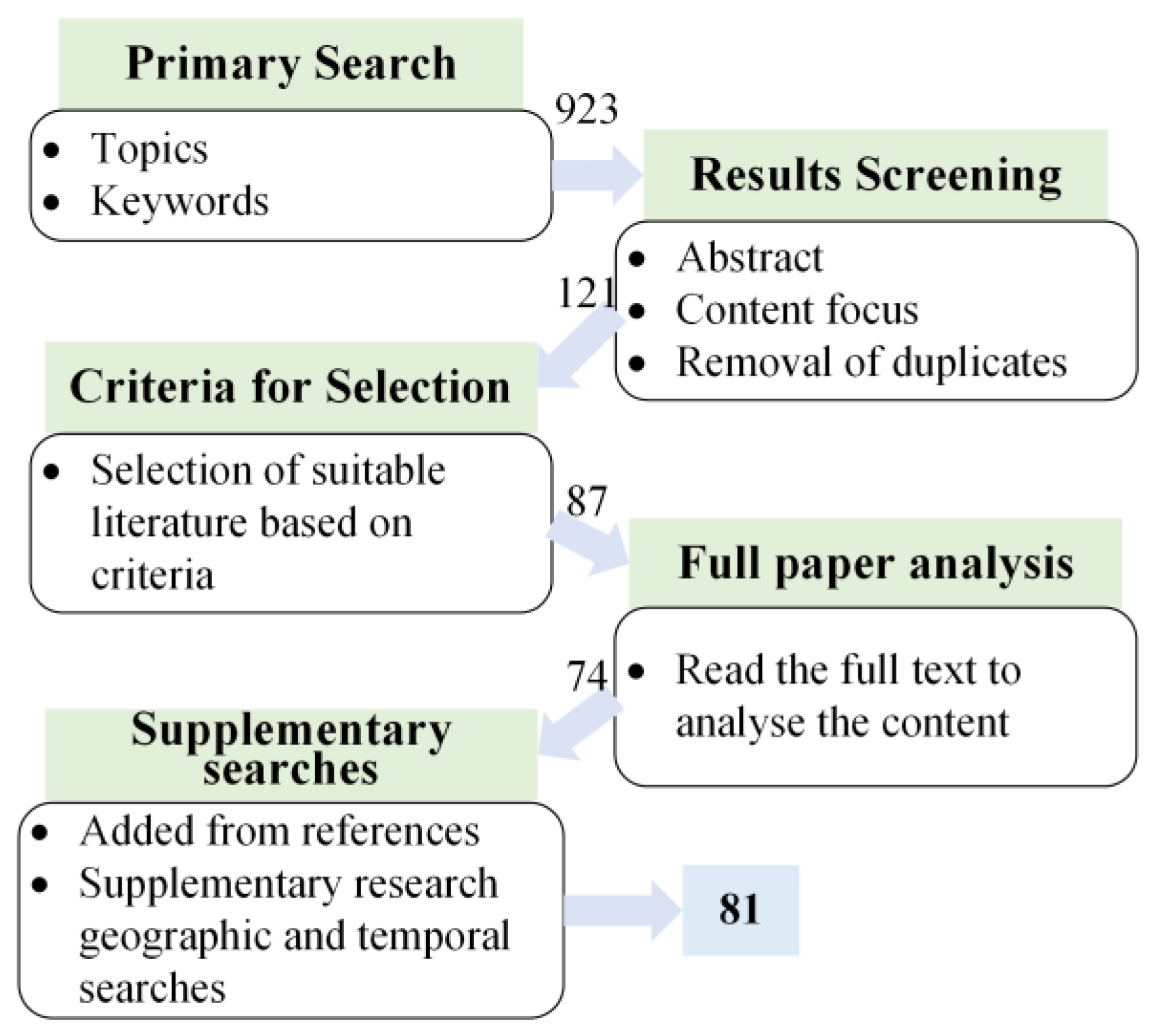
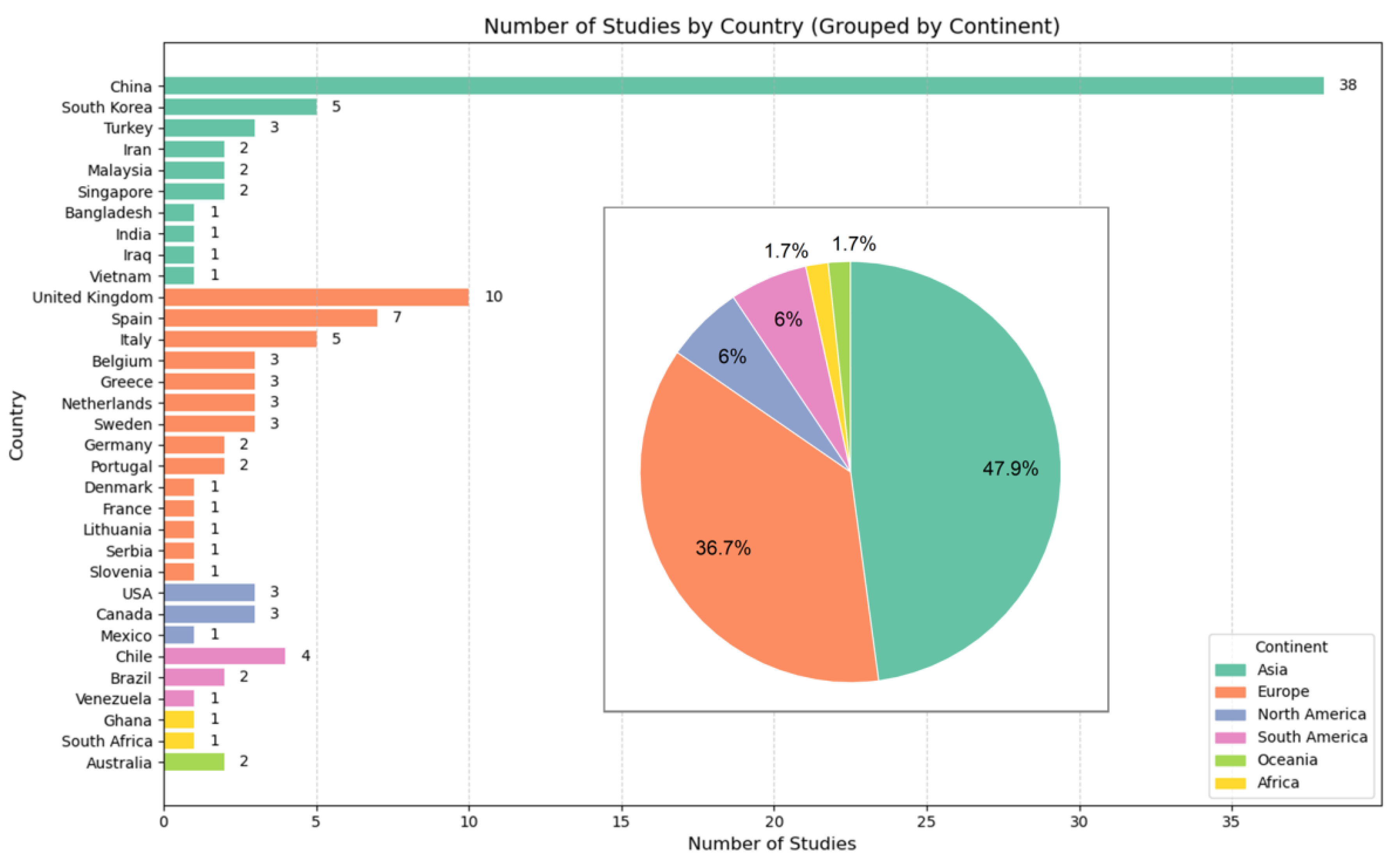
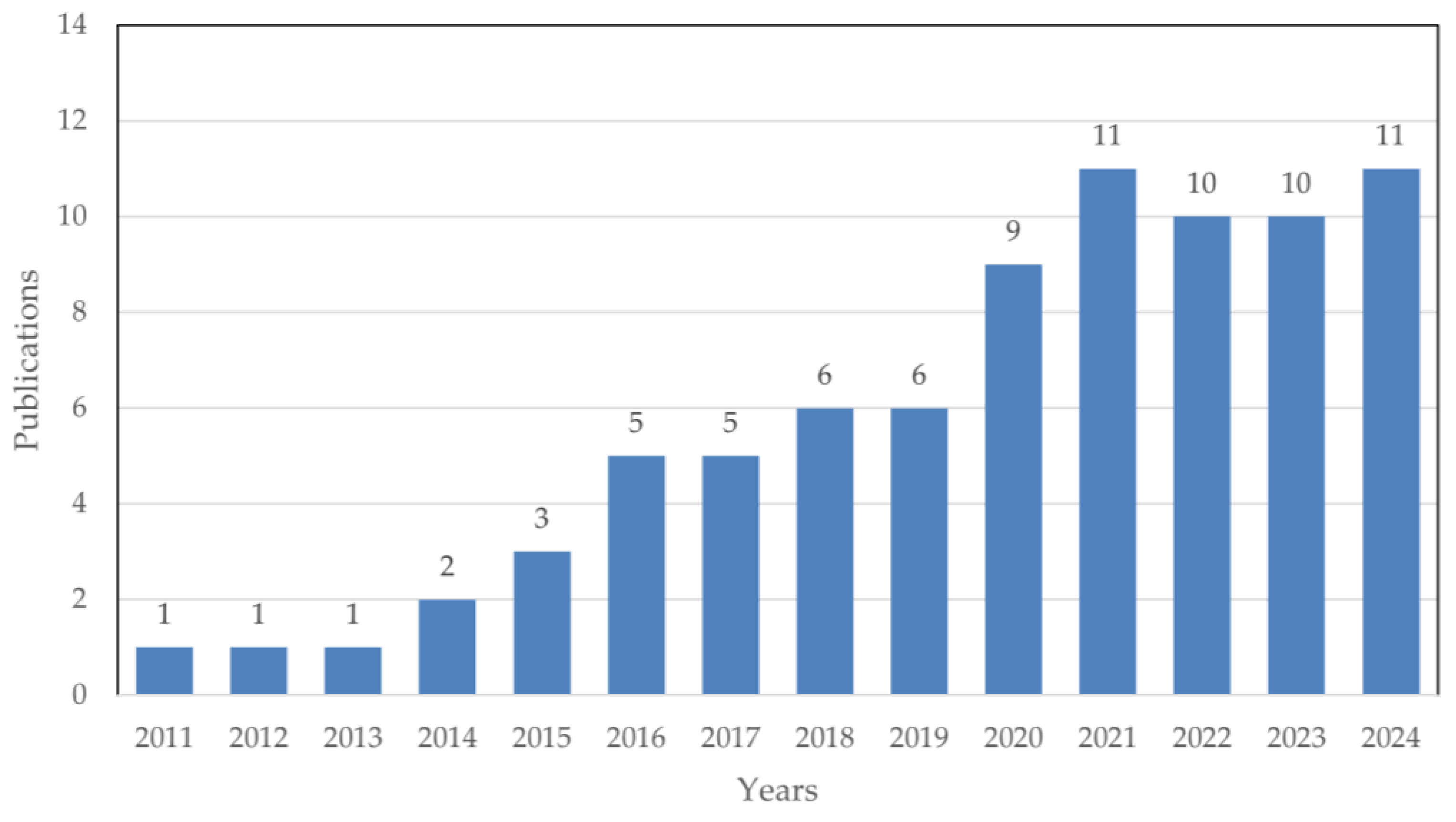
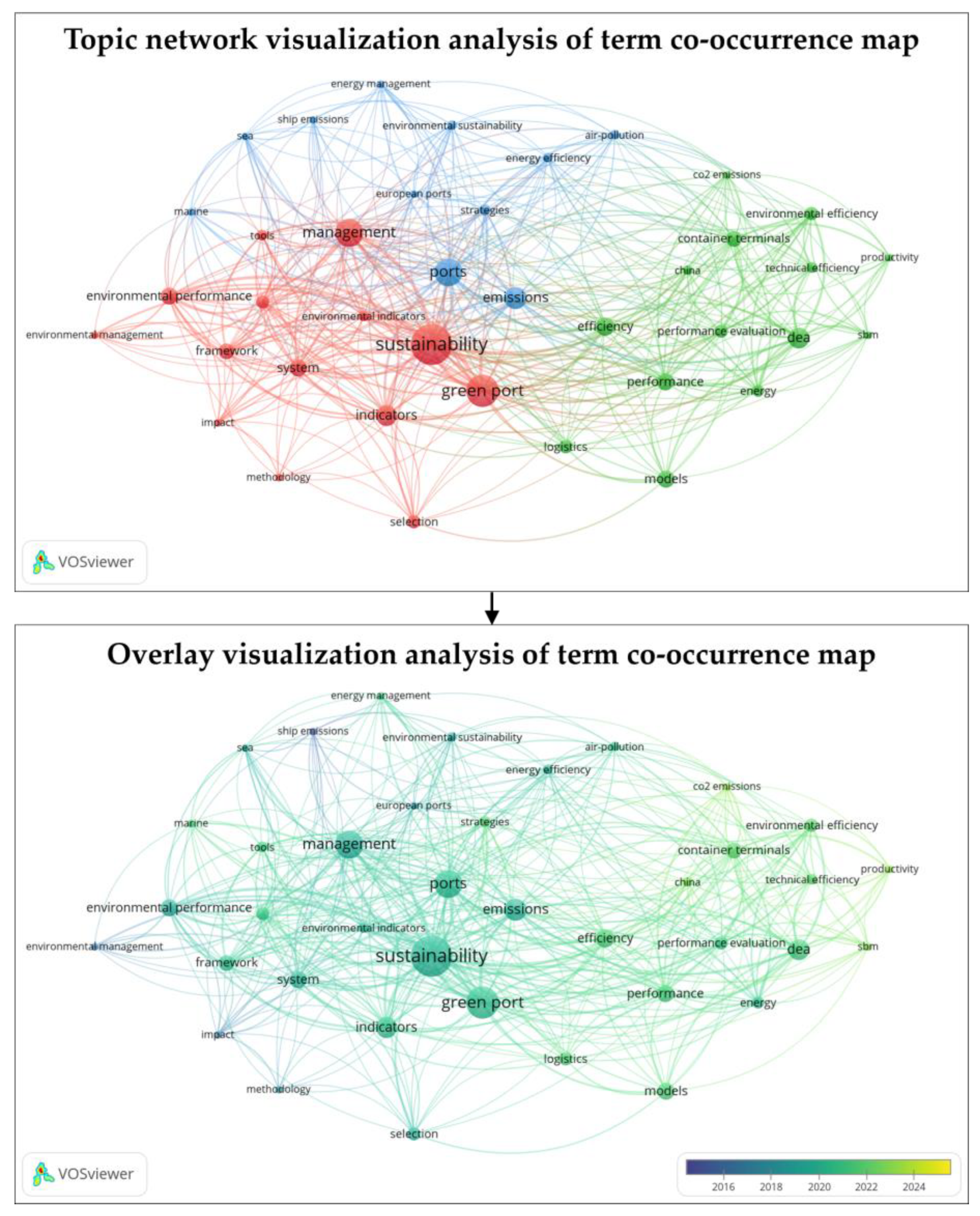
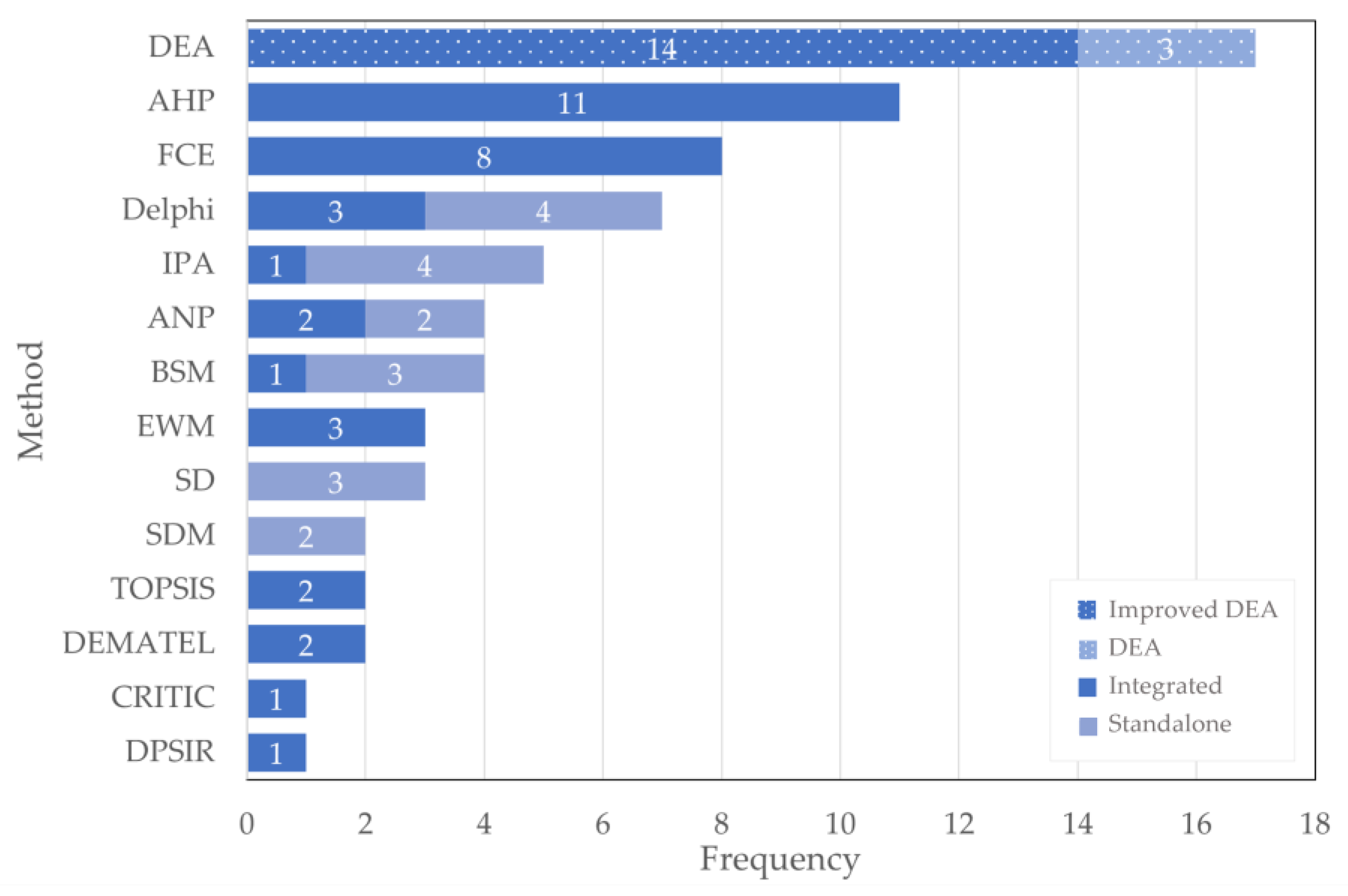


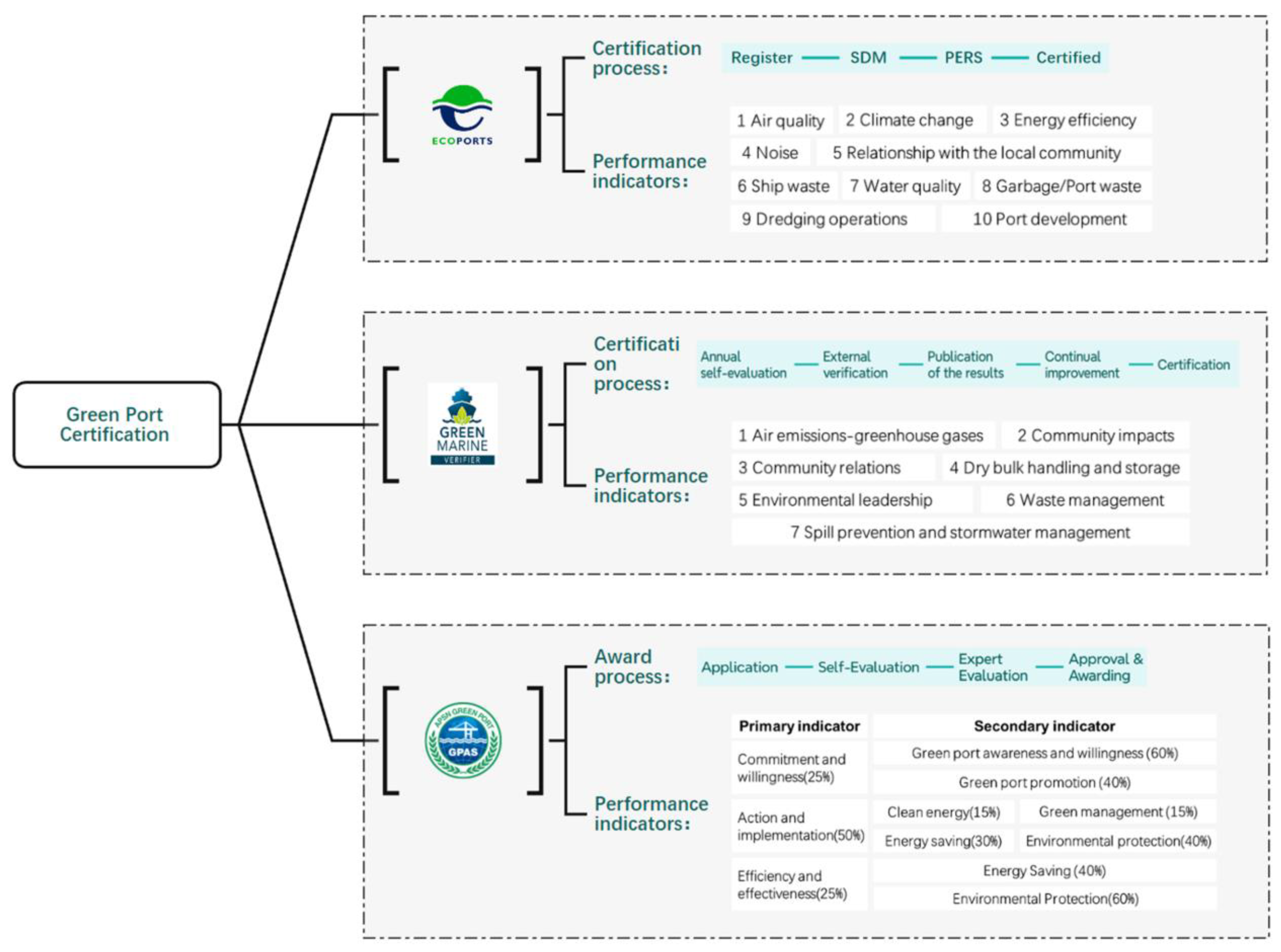
| Criteria | Interpretations |
|---|---|
| Types | From high-quality journals, published monographs, and academic conferences (excluding Graduation thesis) |
| Geographical Coverage | Ensuring comprehensive geographical representation |
| Relevance | Related to the comprehensive evaluation with a focus on green ports (excluding port logistics, shipping, ships, etc.) |
| Citation | Priority is given to more cited and influential literature |
| Authority | From leading scholars and research organizations |
| Subjects | Methods | Undesirable Outputs | References |
|---|---|---|---|
| Environmental efficiency of 24 ports in Europe | DEA | Greenhouse gas emissions | [41] |
| Green efficiency of 18 ports in Asia | Cross-efficiency DEA | NOX and SOX | [44] |
| Eco-efficiency in 24 ports in Europe | SFA | CO2 | [45] |
| Sustainable efficiency of 17 ports in Latin American | SFA | CO2 | [46] |
| Sustainability efficiency of 15 container ports in Asia | Inverse DEA | CO2 and NOX | [47] |
| Efficiency of 17 listed port companies in Asia | Non-radial DEA | NOX | [48] |
| Environmental efficiency of 10 ports in Asia | RAM-Tobit-RAM | CO2 | [49] |
| Environmental efficiency measurement of 11 ports in Asia | CRM-CPM-CEM | PM | [50] |
| Environmental efficiency of 10 ports in Asia and Europe | SBM-DEA | CO2 | [51] |
| Environmental efficiency of 2 ports in Europe | Two-stage DEA | Energy consumption and emissions | [52] |
| Sustainable efficiency of container terminals in Asia | SBM-DEA | CO2 | [53] |
| Technical efficiency of 14 ports in Latin American | DEA-Malmquist | / | [54] |
| Technical environmental efficiency of 8 ports in Asia | Input–output SBM | CO2 | [55] |
| Eco-efficiency of 18 ports in Asia | Super-SBM and GML | NOX | [56] |
| Sustainability efficiency of 23 seaports in Asia | Uncertain DEA | Air and water pollutants | [57] |
| Environmental efficiency of 26 ports in Asia | SBM-DEA | CO2 | [58] |
| Eco-efficiency of 24 ports in Europe | SBM-DEA and SFA | Emissions | [59] |
| Port efficiency of 2 ports in Asia | DEA-SFA-DEA | NOX | [60] |
| Green efficiency of 15 seaports in Asia | Super-SBM-DEA, SFA, Super-SBM-DEA | CO2 | [61] |
| Subjects | Methods | References |
|---|---|---|
| Ecological carrying capacity | Ecological footprint theory | [69] |
| System dynamics theory | [70] | |
| Environmental carrying capacity | AHP and expert scoring method | [71] |
| AHP and information entropy theory | [72] | |
| DEA | [73] | |
| AHP | [71] | |
| Green port competitiveness | Fuzzy-AHP | [74] |
| SBM and EWM-TOPSIS | [75] |
| Years | Subjects | Methods | References |
|---|---|---|---|
| 2024 | PIES | AHP-Fuzzy | [81] |
| 2023 | Port Energy Management | Delphi method | [82] |
| 2023 | Port microgrid operational efficiency | CRITIC-TOPSIS | [83] |
| 2023 | Port self-sufficient wind power energy systems | AHP-EWM | [85] |
| 2024 | Port wind farm site selection | AHP-Fuzzy | [86] |
| 2022 | Feasibility of wave energy utilization in ports | Delphi method | [87] |
Disclaimer/Publisher’s Note: The statements, opinions and data contained in all publications are solely those of the individual author(s) and contributor(s) and not of MDPI and/or the editor(s). MDPI and/or the editor(s) disclaim responsibility for any injury to people or property resulting from any ideas, methods, instructions or products referred to in the content. |
© 2025 by the authors. Licensee MDPI, Basel, Switzerland. This article is an open access article distributed under the terms and conditions of the Creative Commons Attribution (CC BY) license (https://creativecommons.org/licenses/by/4.0/).
Share and Cite
Fei, H.; Shi, H.; Pan, X. A Systematic Review of Green Port Evaluation: Methods, Subjects, and Indicators. J. Mar. Sci. Eng. 2025, 13, 604. https://doi.org/10.3390/jmse13030604
Fei H, Shi H, Pan X. A Systematic Review of Green Port Evaluation: Methods, Subjects, and Indicators. Journal of Marine Science and Engineering. 2025; 13(3):604. https://doi.org/10.3390/jmse13030604
Chicago/Turabian StyleFei, Huaping, Hongda Shi, and Xinying Pan. 2025. "A Systematic Review of Green Port Evaluation: Methods, Subjects, and Indicators" Journal of Marine Science and Engineering 13, no. 3: 604. https://doi.org/10.3390/jmse13030604
APA StyleFei, H., Shi, H., & Pan, X. (2025). A Systematic Review of Green Port Evaluation: Methods, Subjects, and Indicators. Journal of Marine Science and Engineering, 13(3), 604. https://doi.org/10.3390/jmse13030604






